六年级上册英语总复习知识要点(1-3单元)
英语六年级上册U1-U3单元知识点总结
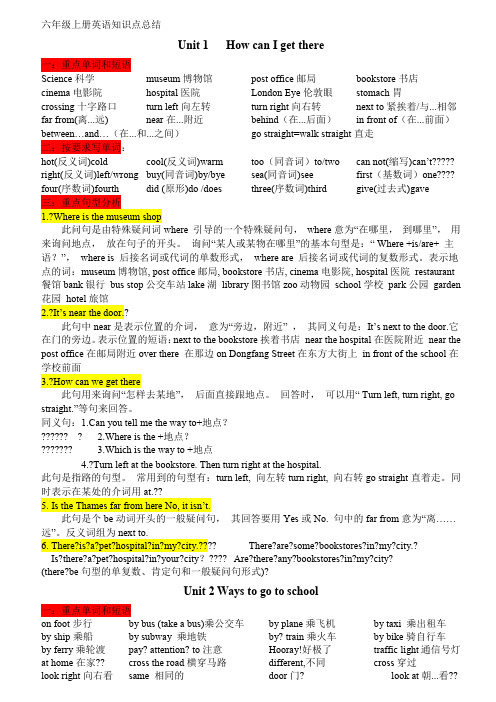
六年级上册英语知识点总结Unit 1 How can I get there一:重点单词和短语Science科学museum博物馆post office邮局bookstore书店cinema电影院hospital医院London Eye伦敦眼stomach胃crossing十字路口turn left向左转turn right向右转next to紧挨着/与...相邻far from(离...远) near在...附近behind(在...后面)in front of(在...前面)between…and…(在...和...之间)go straight=walk straight直走二:按要求写单词:hot(反义词)cold cool(反义词)warm too(同音词)to/two can not(缩写)can’t????? right(反义词)left/wrong buy(同音词)by/bye sea(同音词)see first(基数词)one???? four(序数词)fourth did (原形)do /does three(序数词)third give(过去式)gave三:重点句型分析1.?Where is the museum shop此问句是由特殊疑问词where 引导的一个特殊疑问句,where意为“在哪里,到哪里”,用来询问地点,放在句子的开头。
询问“某人或某物在哪里”的基本句型是:“ Where +is/are+ 主语?”,where is 后接名词或代词的单数形式,where are 后接名词或代词的复数形式。
表示地点的词:museum博物馆, post office邮局, bookstore书店, cinema电影院, hospital医院restaurant 餐馆bank银行bus stop公交车站lake湖library图书馆zoo动物园school学校park公园garden 花园hotel旅馆2.?It’s near the door.?此句中near是表示位置的介词,意为“旁边,附近” ,其同义句是:It’s next to the door.它在门的旁边。
六年级英语上册 1-3单元知识点汇总 新人教版

1-3单元知识点汇总Unit 1 How can I get there?一、主要单词:三、常用表达式:Excuse me 打扰一下Follow me, please! 请跟着我!四、常用句型:1、问路的句型及其答语:问句:Where is the + 地点?在哪儿?答语:It's + 表示地点的词语。
它在…next to the bookstore、near the hospital/post office、over there、on Dongfang Street 、in front of the school2、询问怎么到某地的句型及其答语:问句:How can +主语 + get (to)+地点?怎么到…?同义句型:Can you tell me the way to +地点?/Where is + 地点?/Which is the way to +地点?答语:Turn +方向+表示地点的介词短语。
在…向…方向转at the cinema、at the corner、near the post office例句:Where is the cinema, please? 请问电影院在哪里?It's next to the hospital. 它与医院相邻。
Turn left at the cinema, then go straight. It's on the left. 在电影院向左转,然后直行。
它在左边。
六、主题写作:介绍去某地的路线模板:1、交代目的地的位置及距离The … is near/next to … It is (not) far from …2、说明可以采取的交通方式You can go on foot /by bus /by bike…3、说明路线Go straight . Turn left / right at…范文:How to Get to the Science MuseumWe are going to the science museum tomorrow. The science museum is next to the hospital. It's not far from our school. So we can go there on foot. First, go straight from our school. Next, turn left at the post office and walk for about five minutes. Then turn right at the bookstore. We can find the hospital on the right. Walk straight, and we'll see the science museum.Unit 2 Ways to go to schoolI see 我明白了Go at a green light 绿灯行Stop at a red light 红灯停Wait at a yellow light 等黄灯四、常用句型:1、如何询问对方的出行方式:How do you come(to)+地点?2、如何用must表示必须做某事:某人+must+动词原形(+其它).3、告诫别人不要做某事的句型:Don't +动词原形(+其它).例句:1. How do you go to school? 你怎么去上学?2. Usually I go to school on foot. Sometimes I go by bus. 通常我步行去上学。
六年级上册英语1~3单元重点知识
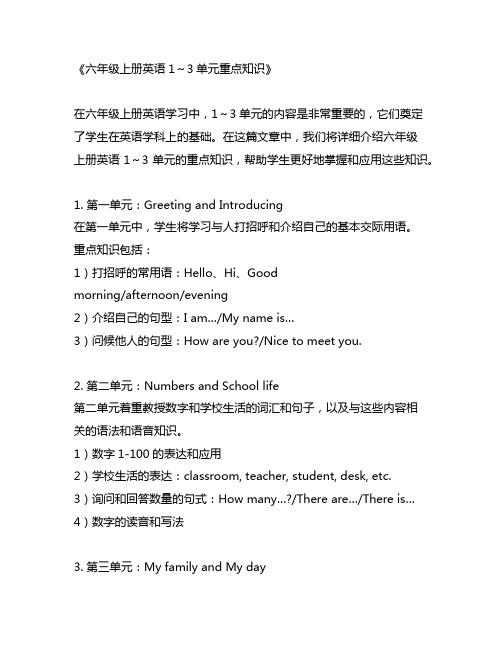
《六年级上册英语1~3单元重点知识》在六年级上册英语学习中,1~3单元的内容是非常重要的,它们奠定了学生在英语学科上的基础。
在这篇文章中,我们将详细介绍六年级上册英语1~3单元的重点知识,帮助学生更好地掌握和应用这些知识。
1. 第一单元:Greeting and Introducing在第一单元中,学生将学习与人打招呼和介绍自己的基本交际用语。
重点知识包括:1)打招呼的常用语:Hello、Hi、Goodmorning/afternoon/evening2)介绍自己的句型:I am…/My name is…3)问候他人的句型:How are you?/Nice to meet you.2. 第二单元:Numbers and School life第二单元着重教授数字和学校生活的词汇和句子,以及与这些内容相关的语法和语音知识。
1)数字1-100的表达和应用2)学校生活的表达:classroom, teacher, student, desk, etc.3)询问和回答数量的句式:How many…?/There are…/There is…4)数字的读音和写法3. 第三单元:My family and My day在第三单元中,学生将学习如何描述自己的家庭和日常生活。
重点内容包括:1)家庭成员的称呼:father, mother, brother, sister, etc.2)家庭成员关系的表达:This is my…/She is my…3)日常生活的描述:get up, have breakfast/lunch/dinner, go to bed, etc.4)时间的表达和描述:morning, afternoon, evening, etc.以上是六年级上册英语1~3单元的重点知识,掌握这些知识对于学生来说是非常重要的。
在学习过程中,学生应该注重听、说、读、写的综合训练,同时注重语言环境的营造,培养学生的英语思维和表达能力。
部编版六年级上册英语全册知识点考点归纳

部编版六年级上册英语全册知识点考点归纳一. Unit 1: Greetings and Introductions- 主要知识点:问候语和自我介绍的表达方式、对话中的礼貌用语等。
- 考点:熟练运用问候语和自我介绍的句型进行实际对话。
二. Unit 2: Daily Routines- 主要知识点:日常活动及时间的表达法、动词的第三人称单数形式、频度副词等。
- 考点:能够描述自己和他人的日常活动,并用适当的频度副词表达频率。
三. Unit 3: Hobbies and Interests- 主要知识点:各类爱好和兴趣的词汇,运动动词的搭配等。
- 考点:能够谈论自己的爱好和兴趣,并用动词的适当形式表达。
四. Unit 4: School Life- 主要知识点:学校生活相关的词汇、句型及日常用语。
- 考点:根据提供的情境,能流利用英语进行交流,描述学校生活的一般情况。
五. Unit 5: Family and Homes- 主要知识点:家庭成员及房屋相关的词汇、形容词的比较级和最高级等。
- 考点:描述家庭成员和房屋的外貌、特点及家人之间的关系,掌握形容词的比较级和最高级的使用。
六. Unit 6: Daily Life- 主要知识点:购物和衣物相关的词汇、句型及日常用语等。
- 考点:能够根据给定的情境,进行购物和衣物方面的交流,描述自己和他人的穿着。
七. Unit 7: Food and Drinks- 主要知识点:食物和饮料相关的词汇、数量词、可数名词和不可数名词等。
- 考点:能够描述所喜欢的食物和饮料,并用数量词正确表达数量。
八. Unit 8: Festivals and Celebrations- 主要知识点:节日和庆祝活动的词汇、句型及常用表达方式等。
- 考点:能够流利描述不同节日和庆祝活动,并参与与之相关的英语对话。
以上是部编版六年级上册英语全册的知识点和考点归纳。
希望对你的学习有帮助!。
人教版六年级英语上1-3单元重点总结
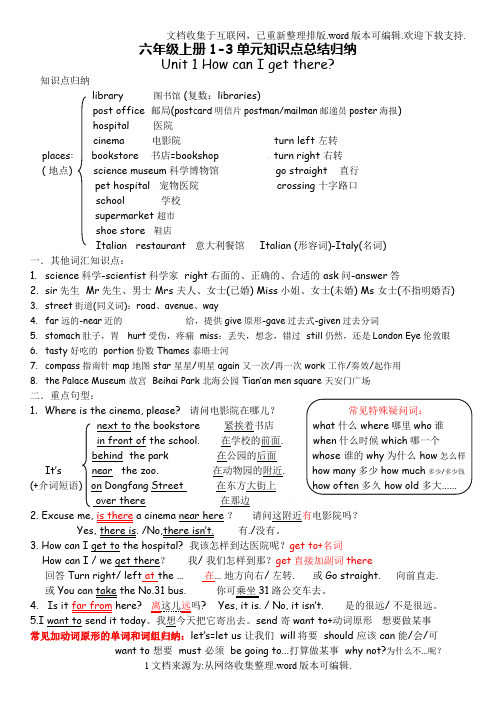
文档收集于互联网,已重新整理排版.word版本可编辑.欢迎下载支持.六年级上册1-3单元知识点总结归纳Unit 1 How can I get there?知识点归纳library 图书馆 (复数:libraries)post office 邮局(postcard明信片postman/mailman邮递员poster海报)hospital 医院cinema 电影院 turn left 左转places: bookstore 书店=bookshop m turn right 右转( 地点) science museum科学博物馆 go straight 直行pet hospital 宠物医院 crossing 十字路口school 学校supermarket 超市shoe store 鞋店Italian restaurant 意大利餐馆 Italian (形容词)-Italy(名词)一.其他词汇知识点:1.science科学-scientist科学家 right右面的、正确的、合适的 ask问-answer答2.sir先生 Mr先生、男士 Mrs 夫人、女士(已婚) Miss小姐、女士(未婚) Ms 女士(不指明婚否)3.street街道(同义词):road、avenue、way4.far远的-near近的给,提供 give原形-gave过去式-given过去分词5.stomach肚子,胃 hurt受伤,疼痛 miss:丢失,想念,错过 still仍然,还是London Eye伦敦眼6.tasty 好吃的 portion份数Thames 泰晤士河pass指南针 map 地图 star 星星/明星 again 又一次/再一次 work 工作/奏效/起作用8.the Palace Museum 故宫 Beihai Park 北海公园 Tian’an men square 天安门广场二.重点句型:1.Where is the cinema, please? 请问电影院在哪儿?next to the bookstore 紧挨着书店in front of the school. 在学校的前面. whenbehind the park 在公园的后面 whoseIt’s near the zoo. 在动物园的附近. how many(+介词短语) on Dongfang Street 在东方大街上 how oftenover there 在那边2. Excuse me, is there a cinema near here ?请问这附近有电影院吗?Yes, there is. /No,there isn’t.有./没有。
(完整)六年级上册英语总复习知识要点(1-3单元)

六年级上册英语总复习知识要点(1-3单元)Unit1Howdoyougothere?单词和短语:.byplane乘飞机 2.onfoot步行 3.bybike骑自行车4.bybus乘公共汽车5.bytrain乘火车6.stop停7.wait等8.trafficlight交通灯9.trafficrule交通规则10.getto 到达句型:.Howdoyougotoschool?你如何去上学?Igotoschoolonfoot.我步行去上学。
2.Howdoesmarygotoschool?玛丽如何去上学?Shegoestoschoolbybike.她骑自行车去上学。
3.HowcanIgettoZhongshanpark?我怎样才能到中山公园?youcangobyNo.15bus.你可以乘15路公交车。
4.Stopataredlight.=Redlightmeansstop.红灯停。
5.waitatayellowlight.=yellowlightmeanswait.黄灯等待。
6.Goatagreenlight.=Greenlightmeansgo.绿灯行7.Inchina,driversdriveontherightsideoftheroad.在中国,司机们靠右侧行驶。
(在美国,澳大利亚,香港,新西兰也是。
)Unit2whereisthesciencemuseum?单词和短语:.postoffice邮局 2.hospital医院 3.cinema电影院4.bookstore书店5.sciencemuseum科学博物馆6.bank银行7.library图书馆8.supermarket超市9.excuseme对不起,打扰一下10.apairof一双11.nextto与…相邻12.afterschool放学以后13.north北14.south南15.east 东16.west西17.turnright向右转18.turnleft向左转19.gostraight直行20.lookfor寻找21.please请句型:.whereisthecinema,please?请问,电影院在哪里?It’snexttothehospital.与医院相邻。
六年级上册一到三单元英语笔记

六年级上册一到三单元英语笔记Unit 1 How can I get there?一、重点单词。
1. science museum(科学博物馆)- “science”是“科学”的意思,例如:Science helps us understand the world better.(科学帮助我们更好地理解世界。
)- “museum”是“博物馆”,可数名词。
2. post office(邮局)- “post”有“邮政、邮寄”的意思,“office”是“办公室”,合起来就是办理邮政业务的地方。
3. bookstore(书店)- 由“book(书)”和“store(商店)”组成。
4. cinema(电影院)- 去电影院看电影可以说“go to the cinema”。
5. hospital(医院)- 如果说“in the hospital”,表示在医院里(不一定是生病住院,可能是看望病人或者在医院工作等);“in hospital”则表示生病住院。
6. crossing(十字路口)- 是“cross(穿过)”的名词形式,例如:Turn left at the second crossing.(在第二个十字路口左转。
)7. turn(转弯)- 常见搭配:“turn left(左转)”“turn right(右转)”“turn around (转身)”。
8. left(左边)- 反义词是“right(右边)”,例如:The bookstore is on the left.(书店在左边。
)二、重点短语。
1. near(在……附近)- 例如:My home is near the school.(我的家在学校附近。
)2. next to(紧挨着)- 它比“near”表示的距离更近,如:The library is next to the post office.(图书馆紧挨着邮局。
)3. in front of(在……前面)- 注意与“in the front of”的区别,“in the front of”表示在物体内部的前面,例如:The teacher stands in the front of the classroom.(老师站在教室的前面,是在教室内部);而“in front of”是在物体外部的前面,如:There is a tree in front of the house.(房子前面有一棵树)。
人教版六年级上册英语1-3单元知识归纳

人教版六年级上册英语1-3单元知识归纳Unit 1:In the first unit, we learn about personal information and greetings. We learn how to introduce ourselves and ask others for their names. We also learn about nationality and how to say where we come from. Additionally, we learn how to greet others and how to say goodbye. We practice simple conversations using these phrases and learn how to express basic needs and preferences.Unit 2:In the second unit, we focus on classroom objects and school subjects. We learn the names of common objects found in a classroom such as books, pens, desks, and chairs. We also learn the names of different school subjects like math, science, and English. Additionally, we learn how to talkabout our schedule or timetable and express what subjects we have on certain days.Unit 3:The third unit is all about hobbies and free time activities. We learn how to talk about our favorite hobbies and activities. We learn vocabulary related to sports, music, and games. We also learn how to express our likes anddislikes using "I like" and "I don't like" phrases. Moreover, we learn how to ask others about their hobbies and engage in simple conversations about our common interests.Throughout these units, we practice listening, speaking, reading, and writing skills. We engage in various activities such as role-plays, pair work, and group discussions to enhance our communication abilities. By the end of these units, we should be able to confidently introduce ourselves, communicate basic personal information, talk about school life, and discuss hobbies and interests.。
六年级英语上册1-3单元知识点归纳

请问这附近有电影院吗?
----Yes, there is. /No,there isn’t.
有./没有。
3.询问怎样到达一个地点:How can I get to the +地点 How can I get there/ here ?
How can I get to the cinema? 我怎样到达电影院?
How can I get to the Fuxing Hospital? 我怎么去福星医院? You can take the No .1 bus .
4 交通规则 (traffic rules ):Stop at a red light . 红灯停 Wait at a yellow light . 黄灯停
你可乘坐 312 路公交车去那儿.
2. Go straight for three minutes.
向前直走在分钟.
3. Turn right/ left at the …
在… 地方向右/ 左转.
4. Walk east/ west/ south/ north for … minutes. 朝东/ 西/南/北/ 走…分钟.
在学校的前面.
behind the park
在公园的后面
It’s
near the zoo.
在动物园的附近.
on the right/left of the bookstore. 在书店的左/右边.
1
east of the bank.
在银行的东边.
far from here.
离这儿很远.
2.---- Excuse me, is there a cinema near here
回答: It’s
near(附近) next to(旁边) behind(后面)
六年级上册英语书1到3单元

六年级上册英语书1到3单元第一单元 How can I get there?一、重点词汇。
1. science museum 科学博物馆。
2. post office 邮局。
3. bookstore 书店。
4. cinema 电影院。
5. hospital 医院。
6. crossing 十字路口。
7. turn left 左转。
8. turn right 右转。
9. go straight 直走。
二、重点句型。
1. — Where is the museum shop? 博物馆商店在哪里?— It’s near the door. 在大门附近。
2. — How can we get there? 我们怎么到那儿?— Turn left at the bookstore. Then turn right at the hospital. 在书店左转,然后在医院右转。
第二单元 Ways to go to school。
一、重点词汇。
1. on foot 步行。
2. by bus 乘公共汽车。
3. by plane 乘飞机。
4. by taxi 乘出租车。
5. by ship 乘轮船。
6. by subway 乘地铁。
7. slow 慢的。
8. down 减少;降低。
9. stop 停下。
二、重点句型。
1. — How do you come to school? 你怎么来学校的?— I usually come on foot. 我通常步行来。
2. — How can I get to the Fuxing Hospital? 我怎么去复兴医院?— Take the No. 57 bus over there. 在那边乘 57 路公共汽车。
第三单元 My weekend plan。
一、重点词汇。
1. visit 拜访。
2. film 电影。
3. see a film 看电影。
4. trip 旅行。
5. take a trip 去旅行。
六年级英语上册各单元复习要点全部

六年级英语上册各单元复习要点全部Establish standards and manage them well. January 26, 2023U n i t1复习要点一、单词1.表示地点的单词:要求必须会拼写science科学 museum博物馆 post office 邮局bookstore书店 bookshop cinema电影院 hospital医院zoo动物园 park公园 library图书馆school学校 restaurant饭店2.方位介词:in 在...里 on在...上 under在...下 next to 紧挨着near 在附近 in front of在...前面→反义词behind 在...后面3.表示路线的词组:Turn left左转 Turn right右转 go straight直走 at the first crossing在第一个十字路口on the left 在左边 on the right 在右边4.其他单词考点:buy →同音词by ; bye know 知道→同音词no give交给过去式gaveright 右边;正确的→反义词left左边;wrong错误的→同音词writethere 那边→对应词here这边→同音词their他们的far远的反义词near 近的 give给→过去式gave5.三会单词,要求必须会读,知道中文意思;ask问 interesting有趣的 Italian 意大利的pizza披萨 street 大街 feature 特点二、句型:1.询问地点:Where is the cinema电影院在哪里It’s near the hospital. 它在医院附近; 划线的部分可替换注:本单元的句型转换:对划线部分提问,如果划线的是方位介词+地点名词,就用where 提问;The museum is behind the hospital.对划线部分提问Where is the museum 大家要注意:wh-词和how引导的问句叫做特殊疑问句,不用Yes或者No 回答;对划线部分提问,给划线的部分找一个特殊疑问词wh-或者how;剩下的部分就变成一般疑问句跟在wh-后面2.询问路线:How can I / we get there 我/我们怎么到那里How can I/ we get to the hospital 我们怎么到医院Turn left at the cinema.在电影院左转; It’s on the right. 它在右边;3.重点句型及考点:⑴ want to 想要+ 动词原形“想要做某事”I want to buy a postcard. 我想买一张明信片;I want to send it today. 我想今天邮寄它;I want to be a businessman.我想成为一名商人;⑵ I’ll 完整形式: I willShe’ll 完整形式 She will will 将要+动词原形一般将来时的构成will+动词原形I’ll ask. 我要问一问;She’ll be here today. 她今天会来这里;⑶A talking robot一个会说话的机器人⑷感叹句: What a great museum 多么棒的博物馆啊What an interesting film 多么有趣的电影啊⑸It’s near the museum. 它在博物馆附近;It’s next to the museum. 它紧挨着博物馆;注:在位置上这两个单词区别不大,但是一定要注意 next 必须和to 连用,而 near后面直接+the + 地点名词⑹There is a pet hospital in my city.我的城市有个宠物医院;→一般疑问句Is there a pet hospital in your city.你的城市有宠物医院吗句子当中有be动词,变成一般疑问句就把Be动词提前,如果原句中有I 问句变you, 如果原句有my 问句变your→肯定回答: Yes, there is. 是的,有;→否定回答:No, there isn’t. 不,没有; 这是There be 句型一般疑问句的回答;→否定句:There isn’t is not a pet hospital in my city. 我的城市没有宠物医院;句子中含有be动词,否定句在be动词后+notis not → 缩写isn’t are not →缩写aren’t I am not →缩写I’m not⑺I know a great Italian restaurant. 我知道一家很棒的意大利餐厅;an Italian restaurant一家意大利餐厅⑻It’s next to the park on Dongfang Street. 它在东方街公园旁边;⑼Robin has GPS Robin 有GPS Robin为第三人称单数所以have要用三单形式has⑽My new GPS works. 我的新的全球定位系统起作用过了;My new GPS也是第三人称单数,所以work要用works⑾We’re in front of the cinema. 我们在电影院前面→同义句The cinema is behind us. 电影院在我们后面;⑿Is the Thames far from here 泰晤士河离这里远吗⒀It’s next to the film museum near the Thames. 它紧挨着泰晤士河附近的电影博物馆;Unit2 复习要点一、单词1.出行方式by bus 乘公交车 by plane 坐飞机 by taxi 坐出租车by ship坐船 by subway坐地铁 by train 坐火车by sled 坐雪橇 by car 坐车开车 by bike 骑自行车by ferry 坐轮渡 on foot步行2.交通规则Traffic rulesSlow down and stop at a yellow light. 黄灯亮时慢下来并停下;Stop and wait at a red light. 红灯亮时停下并等候;Go at a green light. 绿灯亮时通行;3.频度副词:always 总是usually 通常often经常sometimes 有时,偶尔never从不4.其他单词词组考点:must 必须后+动词原形 pay attention to 注意 traffic lights 交通灯early早的→反义词late晚的 walk步行 touch接触,触动fast快的→反义词slow慢的bus→复数buseschild儿童→复数children different不同的→反义词same相同的二、句型:1.询问出行方式:How do you come to school你怎样来学校 I come to school on foot. 我步行来学校;How do you go to school 你怎样去学校 I go to school by bus. 我坐公车来学校;How can we get there 我们怎么到那里 By car. 我们坐车到那里;2.Don’t go at the red light别闯红灯=You must stop at a red light.3.You/I must pay attention to the traffic lights. 你/我必须注意交通信号灯;4.Is this your bike Is this 问句的答句这是你的自行车吗Yes,it is. No, it isn’t. 是,是的./ 不,不是;5.I usually come to school on foot.→同义句I usually walk to school. 我通常步行去上学;注意连词成句on foot 和by+交通工具一定要放到句尾6.I often come to school by bus.→同义句I often take a bus to school.我经常坐公车去上学;7.That’s good exercise.注:exercise作“运动”讲时,时不可数名词,没有复数形式那是很好的锻炼;8.How do you get to the USA from China 你怎样从中国去美国9.10.How can I get to the Fuxing Hospital 我怎么到复兴医院11.12.Take the No. 57 bus over there. 在那边乘57路公共汽车;13.So many pictures of bikes. 这么多自行车的照片;14.They’re from my cousin in the USA. 它们都是从我美国的表弟那儿得来的;15.In the USA people on bikes must wear one.在美国骑自行车的人必须戴头盔;16.The bus is coming. 公共汽车来了;17.You must look right before you cross the road.在你过马路之前,你必须向右望;18.Don’t touch the door.别碰门;19.The park is over there公园在那边;20.Let me read this for you.让我读这个给您听;21.I learn at home. 我在家学习;22.In Alaska, USA ,it snows a lot. 在美国阿拉斯加州经常下雪;这个句子里:a lot = often23.It’s so good to see you 见到你真高兴24.Chinese food is so different from British food. 中国食物与英国食物是如此的不同;25.Let’s take a bus home.→同义句Let’s go home by bus. 让我们坐公车回家吧;26.In the UK and Australia, drivers drive on the left side of the road. 在英国和澳大利亚,司机靠左边行驶;27.In China and the USA drivers drive on the right side of the road . 在中国和美国,司机靠右行驶; 注:常识性问题,有可能考试会考到另外一定要注意,在左边或者右边要用介词 on28.The same as in London. 和在伦敦的一样;29.There is no door on the bus. 公共汽车上没有门;30.本单元的句型转换:对划线部分提问,如果划线的是出行方式,就用how提问;I go to school by bike.对划线部分提问→How do you go to schoolYou can go there on foot. 对划线部分提问→How can I go there大家要注意:划线的部分用How提问;剩下的部分就变成一般疑问句跟在how后面Unit3 复习要点一、单词1.必背动词短语:go ice-skating 去滑冰wash clothes洗衣服draw pictures画画make a snowman 堆雪人go for a picnic去野餐see a film看电影visit my grandparents 看望我的祖父母 take a trip 去旅行 go to the supermarket 去超市2.表示将来时间的时间短语:this morning今天上午 this afternoon今天下午 this evening今天晚上tonight 在今晚 tomorrow 明天 tomorrow morning 明天上午tomorrow afternoon 明天下午 tomorrow evening明天 the day after tomorrow后天next week下周 next month下个月 next year 明年 next Monday下周一注:如果表示在上午、下午、晚上要用:in the morning in the afternoon in the afternoon但是如果morning 这类词前有了修饰词,比如this tomorrow,那么前面就不加介词inI am going to the supermarket this morning.3.表示书籍的词:dictionary 字典→复数dictionar ies an English book一本英语书 comic book 连环画册word book单词书 postcard明信片 story book故事书4.其他单词词组考点:leaf叶子→复数lea ves以f或者fe 结尾的可数名词复数把f或fe变成v再加es二、句型:1. 一般将来时:表示“打算或计划要做某事”①构成: be is, am, aregoing to +动词原形will + 动词原形I’m going to draw a picture tonight.②变成一般疑问句:把be动词提前;Are you going to draw a picture tonight 变一般疑问句I变you, my变your③变成否定句: be动词后加notis not缩写 isn’t are not缩写aren’t I am not →缩写I’m notwill 加not will not 的缩写w won’tI’m not going draw a picture tonight.2.What are you going to do in the nature park. 你打算在自然公园做什么3.I’m going to look for some beautiful leaves. 我打算去寻找一些漂亮的树叶;4.What about you =How about you你呢注:what about 后面如果是动词,要用动词的ing形式What about playing basketball 打篮球怎么样5.John is going to buy his他的 favourite comic book.John打算去买他最喜欢的连环画册; her她的 my我的 your你的6.Sarah is on the phone with Mike. Sarah与Mike正在通话;7.What are you going to do tomorrow = What will you do tomorrow 你明天打算做什么8.I’m going to have an art lesson. 我要上美术课;对划线部分提问: What are you going to do针对动词短语提问用What,剩下部分变成一般疑问句;9.What are you going to do in your lesson你们在课上打算做什么10.11.We’re going to draw some pictures in Renmin Park. 我们要到人民公园去画画;12.Sound s great 听起来很棒12. Have a good time祝你玩的开心13.I have to do my homework now14.我现在得做家庭作业了;have to不得不 +动词原形15.16.John is on his way home. John 在回家的路上;17.My cousin Jack is going to visit me next week. 我的表弟Jack下周打算来看望我;动词后面用人称代词的宾格I→me you→you he→him she→her they→them we →us下面的第26句也是这个考点18.We’re going to the cinema.我们要去电影院;对划线部分提问:Where are you going 你们要去哪里针对地点提问用Where,剩下部分变成一般疑问句;19.We’re going to see a film about space travel.我们要去看有关太空旅行的电影;20.I have lots of comic books about space.我有许多关于太空的连环画册;lots of 许多,大量=a lot of21.I’m going to the supermarket this afternoon. 我今天下午要去超市;对划线部分提问:When are you going to the supermarket 你什么时候去超市针对时间提问用When,剩下部分变成一般疑问句;22.Why not go on Tuesday 为什么不星期二去呢 why not + 动词原形23.24.It’s half price then. 那天是半价;25.I’m going to buy a new comic book.我要去买一本新的连环画册;对划线部分提问:What are you going to buy 你要买什么注:如果划线部分是buy a new comic book,那么这道题的答案就是:What are you going to do26.To the bookstore. = I’m going to the bookstore.27.Can I help you 服务行业用语=What can I do for you28.我能帮你吗有什么需要帮忙的如果你需要帮助: Yes, please. 如果你不需要帮助: No, thanks. 29.My family are going to get together and have a big dinner.我的家人打算聚会,并吃一顿丰盛的晚餐;30.My grandma will tell us a story about Chang’e. 我奶奶将给我们讲一个关于嫦娥的故事;31.Robin and I are going to read a poem. Robin和我打算朗读一首诗;Robin 和我是两个人所以be动词要用are32. F is for family. F代表家人33.You can be together with your family too. 你也可以和你的家人聚在一起;can +动词原形34.I’m going to learn how to swim.我打算学习游泳;35.I’m learning to swim.我正在学习游泳;注:现在进行时的构成是: be+动词的ing形式;如果句子中有Look Listen now 这三个标志词,那么句子要用现在进行时;一定要记住是be+Ving 形式,缺一不可36.How can you learn to swim without going to a pool.不去游泳池你怎么能学会游泳37.without+动词ing38.Learn by doing.在做中学;39.They’re going to Beijing by plane. 他们要坐飞机去北京;对划线部分提问:How are they going to Beijing 他们怎么去北京针对出行方式提问用How,剩下部分变成一般疑问句;Unit4 复习要点一、单词1.必背动词及短语:play sports做运动 climb mountains 爬山 listen to music听音乐watch TV看电视 draw cartoons画漫画 swim游泳 run跑步draw pictures 画画draw a picture read stories读故事read a story play the pipa弹琵琶 play football踢足球play +球类前面不用+the 如果Play后面+乐器,乐器前必须+thedo kung fu 练功夫 dance 跳舞 fly kites 放风筝fly a kite sing English songs唱英文歌sing an English song cook Chinese food 烹饪中国食物study Chinese 学汉语 do word puzzles猜字谜 go hiking去远足2.动词ing形式特殊情况:①去e+ing的情况:write make taketypeuse ride dance havechase②双写结尾字母+ing的情况:run swim stop sitshop plan get3.动词第三人称单数特殊情况:have do gowatchwash teach catchstudyfly carryworry play4.其他单词词组考点以及三会单词:hobby →复数hobbies too→同义词also too→同音词two ; tolet’s →完整形式let us do not →缩写don’t does not →缩写doesn’tthose 那些→对应词these 这些 those 那些→单数thatthese这些→单数this share分享pen pal笔友jasmine 茉莉amazing 令人惊奇的 goal射门share分享club 俱乐部join 加入squirrel 松鼠from that day on 从那天起二、句型:1.询问某人的爱好:----What are your/his/her/Peter’s hobbies 你的/他的/她的/Peter 的爱好是什么I like reading stories and singing.He/She likes swimming and playing football.----What do you likeWhat does he/she/Peter like这也是问爱好的句型注:一定要注意,虽然两句都是问爱好的问句,但是句型可是不一样如果问句中时“某人的 your his her XX’s”,那么句型就是What are/ is ... hobbies/hobby如果问句中是人称代词或人名“ you he she Amy”,那么句型就是What do/does ...like2. 由助动词 Do/Does引出的一般疑问句:Do you/they/ we live in Sydney 你们/他们/我们住在悉尼吗Yes,I/they/we do. No,I/ they/ we don’t.Does he/she /xxx live in SydneyDoes he/she/xxx like doing word puzzles and going hikingYes, he/she does.No, he/she doesn’t.Does 一出现,动词用原形无论是变成一般疑问句还是否定句,我们做题的步骤都是:1.先观察句子中有没有be动词或者情态动词can或者will2.如果有上面的词,变成一般疑问句就是把这几个词提前,变成否定句就是在这几个词后面+not is not=isn’t are not = aren’t I am not = I’m not cannot=can’t will not=won’t 变成一般疑问句还要记得 I 变 you My 变your3.如果没有上面的词,我们就要找“人”来帮忙啦一般疑问句找助动词:Do Does否定句找:don’t doesn’t 帮忙He is a teacher. → Is he a teacherYes, he is. No, he isn’t.He isn’t a teacher.He likes football.→ Does he like footballYes, he does. No, he doesn’t.He doesn’t like football.I like football.→ Do you like football. Yes, I do. No, I don’t.I don’t like football.注:一般现在时:表示经常或习惯性的动作或状态,常与every day /morning /evening ,every week, often, usually ,always, sometimes 等时间状语连用;2. You like tea a lot 你很喜欢茶啊3.What do you like 你喜欢什么4.Cake, for sure 当然是蛋糕;5.I don’t have any cake.我没有蛋糕;6.He’s from New Zealand.他来自新西兰;= He comes from New Zealand.I’m from China.我来自中国;= I come from China.7.He likes doing kung fu and swimming. 他喜欢练功夫和游泳;= He likes to do kung fu and swim.like+Ving like+to +动词原形喜欢做某事 love 的用法和like 一样8.Does he live on the South Island 他住在南岛上吗9.10.He lives on a farm, so sometimes he reads to the cows 他住在一个农场上,所以他有时读给奶牛听;11.Peter like basketball. Peter喜欢篮球;12.He also likes singing. = He likes singing, too.他也喜欢唱歌;13.I’m going to teach him the Chinese song “Jasmine Flower”我打算教他中国歌“茉莉花”动词后面用人称代词的宾格I→me you→you he→him she→her they→them we →us14.My best friend is Xu Wei. 我最好的朋友是徐伟;15.What are your hobbies 你的爱好是什么= What do you like16.Two students like dancing. 两名学生喜欢跳舞;17.One students likes singing. 一名学生喜欢唱歌;18.I’m writing an email to my new pen pal in Australia.我在给我澳大利亚的新笔友写电子邮件;19.Does he live in Sydney 他住在悉尼吗20.Yes, he does. No, he doesn’t.21.Does he like doing word puzzles and going hiking 他喜欢猜字谜和远足吗22.23.Can I also be his pen pal 我也可以成为他的笔友吗24.25.I’m very interested in Australia. 我对澳大利亚非常按兴趣;be interested in 对某事/某物感兴趣 I’m interested in swimming 我对游泳感兴趣;26.Write to me or chat with me. 写信给我或者和我聊天;27.Let’s be friends 让我们做朋友吧Let’s + 动词原形; Let’s 完整形式 Let use and see my new pen pal. 来看看我的新笔友;29.He lives in Australia, but he studies Chinese. 他住在澳大利亚,但是他学习汉语;30.There is a dance class on Sunday at 1 p.m. 星期一下午一点钟有一个舞蹈班;31.What do you do on Sundays 你星期日做什么32.33.See you on the play ground 在操场上与你见面34.Do you want to learn about robots你想了解机器人的只是吗35.36.He teaches students to make robots.他教学生们制作机器人;37.How many hobbies can you find in the text 你能在课文中找到多少种爱好How many +名词复数多少...38.We meet every Wednesday afternoon at 4 o’clock in the dining hall.我们每个星期三下午四点在餐厅见面;39.The cat loves to sleep. 这只猫爱睡觉;40.Jane teaches her sister to draw. Jane教她妹妹画画;41.后面需要跟动词原形的单词或词组总结:can 可以,能must 必须let’s let me 让我们让我want to 想要why not 为什么不 will 将要don’t 禁止... should 应该be going to 将要have to 不得不e.g.: I can go.I must go.Let’s go.Let me go.I want to go.Why not go = Why don’t you goI will go. She will go.Don’t go.I should go.I have to go.I am going to be a head teacher one day.Unit5 复习要点一、单词1.职业:taxi driver出租车司机cleaner清洁工writer作家singer 歌唱家dancer 舞蹈家postman 邮递员football player足球运动员factory worker 工人businessman 商人businesswoman 女商人fisherman渔夫fisherwoman渔妇police officer警察policeman警察policewoman女警察scientist 科学家anartist一位艺术家 pilot 飞行员coach教练 teacher教师cook厨师farmer 农民doctor 医生nurse 护士reporter记者secretary秘书2.其他单词及考点country国家;乡村→复数countries head teacher 校长 a university 一所大学sea大海→同音词see 看见fish鱼→复数fishuse使用→现在分词using type打字→现在分词typing quickly迅速地;快地→反义词slowly慢地if 如果here这里→对应词there 那里 there那里→同音词their他们的二、句型:1.What does he do他是做什么的= What is his job2.What does your mother do 你妈妈是做什么的 What’s your mother’s job3.注:问职业的问句也是有两种,跟上个单元提问爱好一样,一定要注意是某人,还是某人的; 如果是某人you; he ; she; they:;XXWhat does he do What does she do What does Amy do What do you do 如果是某人的: your; his; her; their; XX’sWhat’s your jobWhat’s his jobWhat’s her jobWhat’s Amy’s job问职业的答句都是: He is a ...She is a ...I am a ...4.I’m going to be a head teacher one day. 我想要有一天成为一名校长;= I want to be a head teacher one day.He is going to be a businessman. 他想要成为一名商人;= He wants to be a businessman.5.What about you= How about you 你呢What about +Ving形式: What about swimming去游泳怎么样6.He works near the sea. 他在大海附近工作;对划线部分提问Where does he work 就地点提问用Where, 剩下的部分变成一般疑问句7.He goes to work by car. 他开车去上班;对划线部分提问How does he go to work 就出行方式提问用How, 剩下的部分变成一般疑问句8.Is your father here today 你爸爸今天在这儿吗9.10.He often goes to other countries. 他经常去其他国家;11.She’ll be here today 她今天会来这儿She’ll 完整形式 She will +动词原形12.Do you want to be a head teacher, too 你也想成为一名校长吗13.14.I want to be a businessman. 我想成为一名商人;15.Is your father a postman 你爸爸是一名邮递员吗16.Yes, he is. No, he isn’t.17.He sees lots of fish every day 他每天看到许多鱼;18.He works on a boat. 他在船上工作;19.He goes to work by bike. 他骑自行车去上班;20.He has a very healthy life. 他有一种很健康的生活;21.He works very hard and stays healthy. 他很努力地工作,并且保持着健康;22.We should study hard and stay healthy, too. 我们也应该努力学习并且保持健康;23.She works at a university. 她在一所大学工作;24.He works at sea. 他在海上工作;25.She works in a gym.她在体育馆里工作;26.He works on a rescue plane.他在一架救援机上工作;27.He is good at football. 他擅长足球;He is good at playing football. be good at +Ving形式28.He often goes running after school. 他经常放学之后去跑步;29.If you like sports, you can be a coach. 如果你喜欢体育,你可以做一名教练;30.Sarah likes using computers, and she can type very quickly. Sarah喜欢使用电脑,而且她能快速地打字;31.Robin wants to be a scientist like Wu Yifan’s grandfather.Robin想成为吴一凡的爷爷那样的科学家;32.She wants to work in an office. 她想在办公室里工作;33.Which job do you want to do 你想做哪种工作34.35.That’s not for me. 那不适合我;36.That would be cool. 那会很酷; would + 动词原形Unit6 复习要点一、单词1.表示感觉或者心情的单词:angry生气 afraid害怕 happy开心→反义词sad伤心 unhappy不开心2.动词短语:see a doctor看病 wear warm clothes 穿暖和的衣服 take a deep breath 深深吸一口气count to ten 数到十 do more exercise 做更多的运动3.其他单词及考点:chase追赶→现在分词chasing mouse老鼠→复数micebad坏的→反义词good hurt使受伤 ill有病;不舒服wrong 有毛病 wrong还有“错误的”意思,→反义词rightshould应该后+动词原形 feel 觉得,感到 well 健康;身体好grass草坪 hear听见→同音词here 这里 an ant 一只蚂蚁will not→缩写won’t 后面+动词原形二、句型1. How do you feel 你感觉怎么样 = How are you feeling2. Let’s have some popcorn. 让我们吃些爆米花吧;3. I’ll go and get some drinks. 我去拿点喝的;4. Wait for me 等我5. How could you eat all the popcorn 你怎么能吃光所有的爆米花呢6. We should share 我们应该分享7. If I feel angry, what should I do如果我感到生气,我应该做什么8. After that, you won’t feel so angry. 然后你就不会感到如此生气了;9.Should I count to ten, too 我也应该数到十吗10. What’s What is this cartoon about 这部动画片是关于什么的11. It’s about a cat. 它是关于一只猫的;12. He chases the mice. 他追赶老鼠;13. They’re afraid of him. 他们害怕他;14. Because the mice are bad. 因为老鼠很坏;Because the mouse is bad. 因为这只老鼠很坏;15.They hurt people. 它们伤害人;16. The cat is angry with them. 这只猫很生它们的气;17.Maybe our cat is chasing a mouse now 也许我们的猫现在正在追赶一只老鼠呢18. My mother is worried about me. 我妈妈很担心我;19. Sarah is angry.20.对划线部分提问Sarah 很生气;How does Sarah feel How is Sarah feeling Sarah感觉怎么样21.It’s time to get up. 该起床了;22.What’s wrong 怎么了23.What’s wrong with you 你怎么了What’s wrong with your mother 你的妈妈怎么了24.Your father is ill. 你的爸爸生病了;25.He should see a doctor this morning, so we can’t go to the zoo today.他今天上午需要看医生,所以我们今天不能去动物园了;26.Don’t be sad. 不要伤心;Don’t +动词原形27.We can go next time. 我们可以下次去;He can go next time. 他可以下次去;28.How does Dad feel now 爸爸现在感觉怎么样了 How is Dad feeling now29.Not well. 不是太好;30. Don’t be angry. You should take a deep breath. 不要生气;你应该深呼吸一下;31. You should do more exercise. 你应该做更多的运动;对划线部分提问What should I do 我应该做什么32.You should see a doctor. 你应该去看病;33. You should wear warm clothes. 你应该穿暖和的衣服;34. You should take a deep breath and count to ten. 你应该深深吸一口气,然后数到十;35.It is a sunny morning. 那是一个晴朗的上午;划线的地方一定要用一个形容词: rainy 下雨的 cloudy 多云的 windy 刮风的snowy 下雪的36.Robin is going to sit on the grass when he hears, “Wait”Robin 正打算坐在草地上时,他听到有人说“等等”37.It’s a little ant. 是一只小蚂蚁;38.Please don’t sit on me. 请不要坐在我身上; 介词后面用人称代词宾格 me39.I won’t sit on you. 我不会坐在你身上的; won’t 完整形式 will not40.I can help you. 我能帮助你;He can help the boys find the Italian restaurant. 他能帮助男孩们找到意大利餐厅;help sb. do sth. 帮助某人做某事;41.It is raining. 正在下雨;42.He is stuck in the mud. He is worried.他陷在泥里了;他很发愁;43.Let us help you 让我们来帮你吧44.It is the ant and all of his friends. 是那只蚂蚁和他所有的朋友们;45.They pull Robin out of the mud. 他们把Robin从泥里拉了出来;46.We should always be nice to each other. 我们应该一直对彼此友善;47.My favourite TV show is on soon. 我最喜欢的电视节目马上就要开始了;48.He must be making lots of popcorn. 他一定正在做很多的爆米花; must + 动词原形Recycle 21.A rich old businessman in a small town meets a factory worker.一座小镇里的一位富有的老商人遇到了一位工人;2.Bring me the beautiful flower in three months. 三个月后把画带给我;3.The man with the most beautiful flower can have my money.有最漂亮的花的那个人可以拥有我的钱;4.The poor fisherman brings nothing. 那位贫穷的渔民什么也没有带来;5.You are honest. 你很诚实; honest诚实的;an honest man 一个诚实的人6.The seeds are bad and will never sprout. 种子是坏的,它们绝不会发芽;7.The money is yours.钱是你的了; = It’s your money.8.man→复数men woman→复数women9.People should be honest. 人应该诚实;。
人教版六年级上册英语单词六年级上册英语u1-u3复习要点

六年级上册u1-u3复习要点Unit1 How can I get there?一、重点单词:地点:science museum科学博物馆post office 邮局bookstore 书店cinema 电影院hospital 医院动作:go straight 直走turn left左转turn right 右转方位:in front of :在···前面behind 在···后面near在…旁边next to 紧挨着near 在附近beside 在旁边over 在…上方on the left 在左边on the right 在右边二、重点句型:(1)Is / Are there…?某处有某物吗?肯定回答:Yes, there is. 否定回答:No, there isn’t/aren’t.(2)Where is the + 地点?... ... 在哪里?It’s + 表示地点的名词. 它... ...例句:Where is the cinema? 电影院在哪?It’s next to the bookstore. 在书店的旁边。
(3)How can + 主语+get(to)+ 地点? ... ...怎么到... ...?(如果get后面接的词为副词,则要省略介词to.)例句:How can we get to the park?How can we get there? 我们怎么到那儿?同义问路句型:Can you tell me the way to + 地点?Where is the +地点?Which is the way to + 地点?例句:How can we get to the park?=Can you tell me the way to the park?=Where is the park?= Which is the way to the park?(4 ) Turn left at the bookstore. 到书店左转。
六年级英语复习要点第一到第三单元
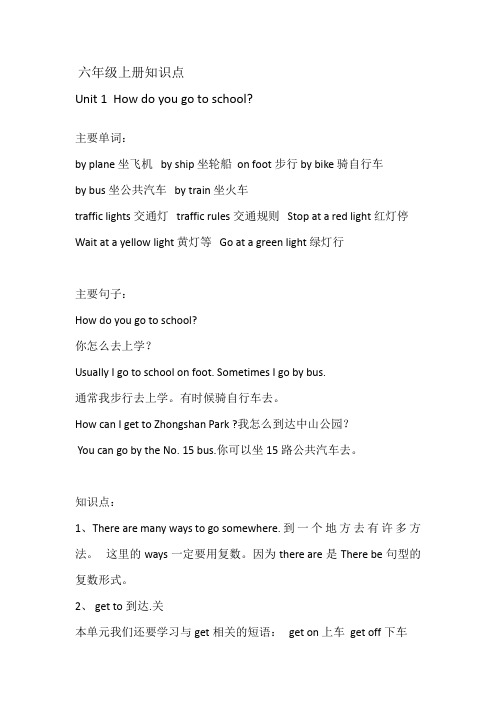
六年级上册知识点Unit 1 How do you go to school?主要单词:by plane 坐飞机 by ship 坐轮船 on foot步行 by bike 骑自行车by bus 坐公共汽车 by train 坐火车traffic lights交通灯 traffic rules交通规则 Stop at a red light 红灯停Wait at a yellow light 黄灯等 Go at a green light 绿灯行主要句子:How do you go to school?你怎么去上学?Usually I go to school on foot. Sometimes I go by bus.通常我步行去上学。
有时候骑自行车去。
How can I get to Zhongshan Park ?我怎么到达中山公园?You can go by the No. 15 bus.你可以坐15路公共汽车去。
知识点:1、There are many ways to go somewhere.到一个地方去有许多方法。
这里的ways一定要用复数。
因为there are是There be句型的复数形式。
2、 get to到达.关本单元我们还要学习与get相关的短语: get on 上车 get off下车3、on foot 步行乘坐其他交通工具大都可以用介词by…, 但是步行只能用介词on 。
4、go to school的前面绝对不能加the,这里是固定搭配。
5、USA 和 US 都是美国的意思。
另外America也是美国的意思。
6 go to the park前面一定要加the.如果要去的地方有具体的名字,就不能再加the , 如果要去的地方没有具体名字,由要在前面加the. go to school除外。
7、How do you go to …?你怎样到达某个地方?如果要问的是第三人称单数,则要用:How does he/she…go to …?8、反义词:get on(上车)---get off(下车) near(近的)—far(远的) fast(快的)—slow(慢的) because(因为)—why(为什么) same(相同的)—different(不同的)9、近义词: see you---goodbye sure---certainly---of course10、频度副词:always 总是,一直 usually 通常 often经常 sometimes 有时候 never 从来不Unit 2 Where is the science museum?主要单词:library 图书馆 post office 邮局 hospital医院 cinema 电影院 bookstore书店 science museum科学博物馆 turn left向左转 turn right 向右转 go straight 直行 north北 south南 east 东 west西主要句子:Where is the cinema, please? 请问电影院在哪里?It’s next to the hospital. 它与医院相邻。
六年级上册1--3单元重点内容整理

Unit 1 In ChinaI重点词汇:1.动词过去式:see—saw do—did go—went get—got come--came am/is—was eat—ate have—hadtell—told; say—said run—ran 2.形容词比较级,最高级:cheap—cheaper—cheapest big—bigger—biggest large—larger—largest high—higher—highest heavy—heavier—heaviest tall—taller—tallest3.名词复数:peach--peaches butterfly—butterflies monkey—monkeys knife—knives city—cities country—countries leaf--leaves tomato—tomatoes potato—potatoes kangaroo--kangaroos4.动词单三形式:fly—flies have—has do—does study--studiesII.重点短语1.summer vacation 暑假2.winter vacation 寒假3.be famous for 因…而著名4.by train 乘火车5.by plane 乘飞机6.in the west of China 在中国的西面7.look at 看8.in East Asia 在东亚9.world-famous w闻名于世的10. the City God Temple城隍庙11.be afraid of 害怕…12. West Lake 西湖III.重点句型:1.Where did you go on your summer vacation?--I went to Guangzhou with my parents.2.What did you do there?--we ate seafood, had morning tea and tasted soup.3.Where is Xining?--It’s in the west of China.4.What’s Xining famous for?-- It’s famous for temples.5.How was your summer vacation?--It was great.6.What’s the weather like there?--It’s cool in summer.IV.话题作文(描写一座著名的城市)BeijingBeijing is the capital of China. It is in the north of China. Beijing is famous for its culture and its food. Peking Opera is world-famous. There are many kinds of local food in Beijing .Beijing duck is the most famous one. You can also visit the Great Wall, the Summer Palace and Tian’an men square.Unit 2 Around the WorldI重点短语1.in the middle of在…的中部2.Eiffel Tower 埃菲尔铁塔3.Louvre 卢浮宫4.more than 多于,超过5.Spring Festival 春节6.the Opera House 歌剧院7.maple leaves 枫叶8.the White House 白宫9.the Big Ben 大本钟10.the CN Tower 加拿大国家电视塔II.重点句型1.Where do you want to go this winter vacation?--I want to go to London. It’s in the southeast of the UK.2. What do you want to do there/--I want to visit the British Museum and see Big Ben. It’s a large clock.3.What do you know about Canada?--Canada is a big country. It’s famous for maple leaves.4. What language do people speak there?--People there speak English and French.5. What country is this? --It’s Canada.6.What can you do there?--I can visit the CN Tower and take photosIII.话题作文(描写一个熟悉的国家)The UKThe UK is a small but beautiful country. It’s famous for the British Museum and the Big Ben. People there speak English. London is a very beautiful city. It’s in the southeast of the UK. You can visit the London Eye there and take beautiful photos there.Unit 3. Animal WorldI重点词汇1.climb trees 爬树2.like to do sth/ like doing sth喜欢做某事3.run very fast跑得特别快4. swim very well游得特别好5.spend some time doing sth花费时间做某事6.look like看起来像7.of course 当然8.live in Jinchang生活在在金昌9.pick up捡起10.every night每天晚上11.be covered with 被..覆盖y eggs 下蛋;产卵13.look after 照顾14.an animal keeper动物饲养员15.lose sight 失明16.decide to do sth决定做某事17.cross the street 过马路18.turn left/ right左转/右转19.run out of the classroom跑出教室20.push away推开II.重点句型:1.What animals do you like?--I like butterflies. They are insects. They can fly, and they are beautiful.2. Do you like animals?—Yes, I do. / No, I don’t3.What are your favourite animals?--My favourite animals are monkeys.4.I like butterflies very much.5.What kind of animals are whales?--They are mammals.6. Penguins are bird. Sharks are fish.7.What can they do? –They can run very fast.8.What do they like to eat?--They like to eat peaches and bananas.9.What do they look like?--They are big and strong.III. 话题作文(描述一种自己最喜欢的动物)My Favourite AnimalMy favourite animals are rabbits. They are mammals. They each have two long ears and two red eyes. They can jump, and they eat grass. They are very lovely and cute. I like them very much.。
人教版六年级英语上册复习知识点(1-3)

第一单元知识点词组 1.go to school去上学 2.get to到达 3.nature park 自然公园4. No.12 bus12路公交车5.go somewhere去某地方6.on foot 步行7.by subway /plane/ship/bike/car/bus/train乘地铁/飞机/轮船/自行车/小汽车/公交车/火车 8.what about怎么样9.go to the park去公园10.this afternoon今天下午e to来到12.bus stop公交车站13.post office邮局14.look at看 1 5.traffic light交通灯14.16.traffic rule交通规则17.red /green/yellow light红/绿/黄灯18.the same一样19.every country每个国家20.there are 有21. in China / the US / England / Australia在中国/美国/英国/澳大利亚22.on the right/lef t在右/左边23.on the right /left side of在...右/左边24.fast food快餐25.too expensive太贵词形:(一)同音词 1.know-no 2.by-bye-buy 3.see-sea/c 4.there-their(二)单变复 1.this-these2.bus-buses3.people-people 4.country-countries(三)反义 1.always-never 2.why-because 3.far-near4.easy-harde-go6.remember-forget7.different-same8.right-left数词: 1.first-one 2.second-two 3.third-three4.fifth-five5.eighth-eight6.ninth-nine7.twelfth-twelve8.twentieth-twenty-let (五)完整形式 1.No.-number 2. let’sus(六)其他 1.easy副easily 2.stop现分stopping3.different名difference4.drive名driver5.mus t同义haveto重点句子:1.There are many ways to go somewhere.去某些地方有许多方式。
人教版六年级英语上册 1-3单元知识总结

六年级上册Unit 1 How can I get there?表示具体地点的词语:城市c i ty、乡村v i llage、学校sch oo l、公园p ar k、动物园z oo、邮局post office、电影院cinema、医院h o spital、宠物医院pet hospital、书店b oo kstore、科学博物馆science museum、十字路口cr o ssing (at +具体地点例如:at the zoo)表示方位的词语:在…旁边next to、在…旁边beside、在…附近near、在…前面in front of、在…后面behind、在…中间between…and…、在左边on the left of、在右边on the right 、在那儿over there 在十字路口at the crossing向左转turn left、向右转turn right、直行go straight1.表示某地有某建筑物用There be 句型:There is a cinema. 这里有一个电影院。
一般疑问句:Is there a cinema ? 这里有电影院吗?2.询问某地在哪儿用特殊疑问词Where:Where is the cinema? It’s next to the bookstore.电影院在哪里?它在书店隔壁。
3.表示两建筑物间的位置关系用方位词语:The bookstore is next to the cinema. 书店在电影院旁边。
4.询问怎样到达某地:How can I get to the bookstore? Turn left at the cinema. 我怎样到达书店?在电影院左转.(如果get 后面接的是地点副词如:there 、home等不用加to例如:How can I get there)5.Turn right at the hospital. 在医院右转。
PEP小学英语六年级上册1-3单元重点
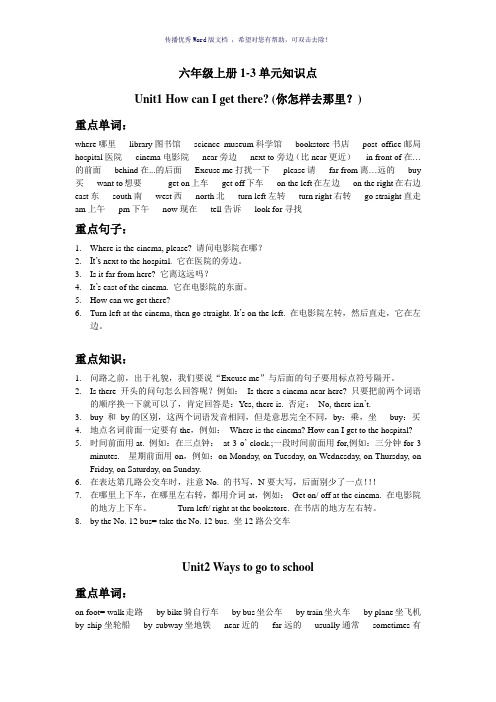
六年级上册1-3单元知识点Unit1 How can I get there? (你怎样去那里?)重点单词:where哪里library图书馆science museum科学馆bookstore书店post office邮局hospital医院cinema电影院near旁边next to旁边(比near更近)in front of在…的前面behind在...的后面Excuse me打扰一下please请far from离…远的buy 买want to想要get on上车get off下车on the left在左边on the right在右边east东south南west西north北turn left左转turn right右转go straight直走am上午pm下午now现在tell告诉look for寻找重点句子:1.Where is the cinema, please? 请问电影院在哪?2.It’s next to the hospital. 它在医院的旁边。
3.Is it far from here? 它离这远吗?4.It’s east of the cinema. 它在电影院的东面。
5.How can we get there?6.Turn left at the cinema, then go straight. It’s on the left. 在电影院左转,然后直走,它在左边。
重点知识:1.问路之前,出于礼貌,我们要说“Excuse me”与后面的句子要用标点符号隔开。
2.Is there 开头的问句怎么回答呢?例如:Is there a cinema near here? 只要把前两个词语的顺序换一下就可以了,肯定回答是:Yes, there is. 否定:No, there isn’t.3.buy 和by的区别,这两个词语发音相同,但是意思完全不同,by:乘,坐buy:买4.地点名词前面一定要有the,例如:Where is the cinema? How can I get to the hospital?5.时间前面用at. 例如:在三点钟:at 3 o’ clock.;一段时间前面用for,例如:三分钟for 3minutes. 星期前面用on,例如:on Monday, on Tuesday, on Wednesday, on Thursday, on Friday, on Saturday, on Sunday.6.在表达第几路公交车时,注意No. 的书写,N要大写,后面别少了一点!!!7.在哪里上下车,在哪里左右转,都用介词at,例如:Get on/ off at the cinema. 在电影院的地方上下车。
pep六年级上册1至3单元知识点
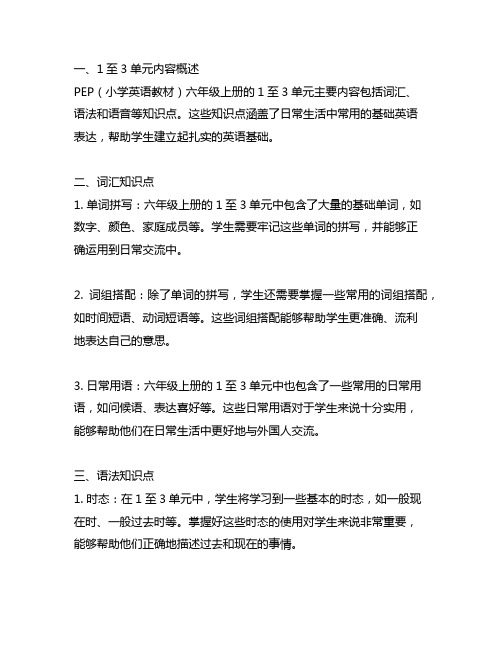
一、1至3单元内容概述PEP(小学英语教材)六年级上册的1至3单元主要内容包括词汇、语法和语音等知识点。
这些知识点涵盖了日常生活中常用的基础英语表达,帮助学生建立起扎实的英语基础。
二、词汇知识点1. 单词拼写:六年级上册的1至3单元中包含了大量的基础单词,如数字、颜色、家庭成员等。
学生需要牢记这些单词的拼写,并能够正确运用到日常交流中。
2. 词组搭配:除了单词的拼写,学生还需要掌握一些常用的词组搭配,如时间短语、动词短语等。
这些词组搭配能够帮助学生更准确、流利地表达自己的意思。
3. 日常用语:六年级上册的1至3单元中也包含了一些常用的日常用语,如问候语、表达喜好等。
这些日常用语对于学生来说十分实用,能够帮助他们在日常生活中更好地与外国人交流。
三、语法知识点1. 时态:在1至3单元中,学生将学习到一些基本的时态,如一般现在时、一般过去时等。
掌握好这些时态的使用对学生来说非常重要,能够帮助他们正确地描述过去和现在的事情。
2. 语法结构:学生还需要掌握一些基本的语法结构,如肯定句、否定句、疑问句等。
这些基本的语法结构是构建语言表达能力的基石,对学生的语言能力提升有着重要的作用。
四、语音知识点1. 发音准确性:在1至3单元中,学生将学习一些基础的英语发音规则,包括元音、辅音的发音技巧等。
通过反复练习,帮助学生提高发音的准确性,使他们能够更加清晰地表达自己的意思。
2. 语音连读:学生还需要学习一些基本的语音连读规则,如连读音、重读音等。
这些规则能够帮助学生更好地理解和模仿地道的英语发音,提高他们的口语表达能力。
五、总结PEP六年级上册的1至3单元涵盖了大量的英语基础知识,包括词汇、语法和语音等方面。
通过系统的学习和练习,学生能够建立起扎实的英语基础,为今后的英语学习打下坚实的基础。
这些知识点也是学生未来学习更复杂英语知识的基础,对于学生的英语学习之路具有重要的意义。
在前面的内容中,我们已经对PEP六年级上册1至3单元的知识点进行了概述,包括词汇、语法和语音等方面。
人教版六年级英语上册复习知识点(1-3)

第一单元知识点词组1.go to school去上学 2.get to到达 3.nature park 自然公园4. No.12 bus12路公交车5.go somewhere去某地方6.on foot 步行7.by subway /plane/ship/bike/car/bus/train乘地铁/飞机/轮船/自行车/小汽车/公交车/火车 8.what about怎么样9.go to the park去公园10.this afternoon今天下午e to来到12.bus stop公交车站13.post office邮局14.look at看 15.traffic light交通灯14.16.traffic rule交通规则17.red /green/yellow light红/绿/黄灯18.the same一样19.every country每个国家20.there are 有21. in China / the US / England / Australia在中国/美国/英国/澳大利亚22.on the right/lef t在右/左边23.on the right /left side of在...右/左边24.fast food快餐25.too expensive太贵词形:(一)同音词 1.know-no 2.by-bye-buy 3.see-sea/c 4.there-their(二)单变复 1.this-these2.bus-buses3.people-people 4.country-countries(三)反义 1.always-never 2.why-because 3.far-near4.easy-harde-go6.remember-forget7.different-same8.right-left数词: 1.first-one 2.second-two 3.third-three4.fifth-five5.eighth-eight6.ninth-nine7.twelfth-twelve8.twentieth-twenty(五)完整形式 1.No.-number 2. let’s-let us(六)其他 1.easy副easily 2.stop现分stopping3.different名difference4.drive名driver5.mus t同义have to重点句子:1.There are many ways to go somewhere.去某些地方有许多方式。
- 1、下载文档前请自行甄别文档内容的完整性,平台不提供额外的编辑、内容补充、找答案等附加服务。
- 2、"仅部分预览"的文档,不可在线预览部分如存在完整性等问题,可反馈申请退款(可完整预览的文档不适用该条件!)。
- 3、如文档侵犯您的权益,请联系客服反馈,我们会尽快为您处理(人工客服工作时间:9:00-18:30)。
六年级上册英语总复习知识要点(1-3
单元)
Unit1
Howdoyougothere?
单词和短语:
.
byplane乘飞机 2.onfoot步行 3.bybike骑自行车4.bybus乘公共汽车5.bytrain乘火车6.stop停7.wait等8.trafficlight交通灯9.trafficrule交通规则10.getto 到达
句型:
.
Howdoyougotoschool?你如何去上学?
Igotoschoolonfoot.
我步行去上学。
2.Howdoesmarygotoschool?玛丽如何去上学?
Shegoestoschoolbybike.
她骑自行车去上学。
3.HowcanIgettoZhongshanpark?我怎样才能到中山公园?
youcangobyNo.15bus.你可以乘15路公交车。
4.Stopataredlight.=Redlightmeansstop.红灯停。
5.waitatayellowlight.=yellowlightmeanswait.黄灯等待。
6.Goatagreenlight.=Greenlightmeansgo.绿灯行
7.Inchina,driversdriveontherightsideoftheroad.
在中国,司机们靠右侧行驶。
(在美国,澳大利亚,香港,新西兰也是。
)
Unit2
whereisthesciencemuseum?
单词和短语:
.
postoffice邮局 2.hospital医院 3.cinema电影院4.bookstore书店5.sciencemuseum科学博物馆6.bank银行7.library图书馆8.supermarket超市9.excuseme对不起,打扰一下10.apairof一双11.nextto与…相邻12.afterschool放学以后13.north北14.south南15.east 东16.west西17.turnright向右转18.turnleft向左转19.gostraight直行20.lookfor寻找21.please请
句型:
.
whereisthecinema,please?请问,电影院在哪里?
It’snexttothehospital.与医院相邻。
2.
whereisthepostoffice?
邮局在哪里?
It’seastofthecinema.
在电影院的东面。
3.
Getoffatthecinema.Thenwalkstraightforthreeminutes.在电影院下车,然后直行3分钟。
4.
Iwanttobuyapairofshoes.我想买一双鞋。
Unit3
whatareyougoingtodo?
单词和短语:
.
takeatrip去旅行 2.readamagazine看杂志3.gotoacinema去电影院4.tomorrow明天5.tonight今晚6.thismorning今天早上7.thisafternoon今天下午8.thisevening今天晚上9.nextweek下周10.postcard明信片11.magazine杂志12.dictionary字典icbook漫画书14.newspaper报纸15.fruitstand水果店16.petshop 宠物商店17.abusyweekend一个忙碌的周末
句型:
.whatareyougoingtodothisevening?你今天晚上将会做什么?
I’mgoingtovisitmygrandparents.
我将会拜访我的祖父母。
2.
whatisyourfathergoingtodotomorrow?你父亲明天将会做什么?
He’sgoingtoreadbooks.
他将会看书。
3.
whereareyougoingthisafternoon?
你今天下午将会做什么?
I’mgoingtothebookstore.
我将会去书店。
4.
whatareyougoingtodo?
你将会做什么?
I’mgoingtobuyacomicbook.
我将要买一本漫画书。
5.
whenareyougoing?
你什么时候去?
I‘mgoingat5:00.
我将在5点去。
6.I’mgoingtohaveabusyweekend.
我将会过一个繁忙的周末。
7.Iwanttobeascienceteacheroneday.
我想有一天成为一名科学老师。
语法:一般将来时
将来时的标志词有:tomorrow,thismorning/afternoon/evening/weekend,next week,tonight等
句型结构:主语+be动词(am,is,are)+goingto+动词原形。
begoingto=will。
